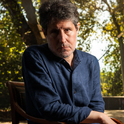At one point in David Lodge's novel Small World, a graduating student visits his tutor for some career advice. "I am thinking of joining the army," the young scholar says. "My dear boy," the tutor replies, "If it's violence you want, try literary journalism!"
In fact, real violence is rare in the republic of letters. Passing scuffles and spitting contests happen sporadically, but genuine carnage occurs with only meteoric infrequency.
The critic James Wood surely knows this better than most. In July 2000, Wood effectively made his name with an important piece of siege ballistics published in The New Republic. Commissioned to review a work of debut fiction by a young British author, Zadie Smith's White Teeth, Wood used his assignment to scope out a larger enemy. "A genre is hardening," Wood wrote, taking a long look through his critical telescope, "a landscape lively and varied and brightly marked, but riven by dead gullies."
This was the unreal kingdom of "hysterical realism," a postmodern realm peopled by "inhuman stories" that worked to disguise themselves by "a showy liveliness, a theatricality, that almost succeeds in hiding the fact that they are without life: liveliness hangs off them like jewellery." Assisted by dramatic circumstance, Wood would complete his cannonade pencil sketch of this shadowland fourteen months later, writing scarcely four weeks after 11th September 2001 in the pages of The Guardian. The idea "of the novelist as a kind of Frankfurt School entertainer," Wood observed, "a cultural theorist, fighting the culture with dialectical devilry—has been woefully influential, and will take some time to die." But Wood still had faith that a corpse would be coming: "a space may now open, one hopes, for the kind of novel that shows us that human consciousness is the truest Stendhalian mirror, reflecting helplessly the newly dark lights of the age."
Who could disagree? The following Saturday, one Zadie Smith, the author of White Teethstepped-up to the crease in the same paper, only to go pieces at the very first ball. Apparently suffering from a kind of literary Stockholm syndrome, Smith started out by surrendering: "hysterical realism," she confessed, "was a painfully accurate term for the sort of overblown, manic prose to be found in novels like my own White Teeth." Her essay went on to rally a weak plea for pluralism, but the damage had already been done. It was clear by the evening that Wood held the field.
That evening has now lasted eight years. In the intervening period, propelled by the articulacy and coherency of his positions, Wood's star has soared even higher—to a tailor-made professorship at Harvard and the chief fiction critic job at The New Yorker. The owner of what some critics have called an "awesome cultural authority," Wood's position in the literary critical firmament today seems unassailable.
And yet—those watching closely may have noticed in 2008 an unsettling network of cracks starting to appear. Paradoxically, the first was probably the publication of Wood's slim manual How Fiction Works in February 2008. On the one hand, the book was a triumphant exercise in professional positioning. On the other hand, How Fiction Works had the unfortunate side-effect of letting the cat out of the bag. It would henceforth be clear to would-be assassins that Wood was King Critic, and hence the target to aim at. And he had, moreover, set out for all to see the details of the finest weapons in his arsenal. In the aftermath of the book's publication, Wood acquired a gadfly: Edmond Caldwell's Contra James Wood blog, consisting of a steady stream of intellectual abuse shot in his general direction.
In the meantime, the serious work of Stendhalian mirroring which Wood had summoned forth from the Guardian in 2001 finally appeared: Joseph O'Neill's Netherland, seven years in the making. Wood was pleased and, from his new command position at the New Yorker, supplied a glowing commendation of the book, comparing O'Neil to Naipul and describing his debut as "masterly."
This was not unexpected. Thematically, temperamentally and stylistically, it would be difficult to encounter a better embodiment of Wood's literary program than O'Neil's tasteful tale of conflicted male selfhood. In early November, however, New York Review of Books editor Robert Silvers shot the starting-pistol for the skirmish to come. Profiled in The San Francisco Chronicle in anticipation of the upcoming 45th anniversary edition of his paper, the impish Silvers turned over the corner of one of his cards, referring to "an ambitious essay, a daring and original piece by a brilliant mind" which he has been especially delighted to include in the forthcoming issue. The brilliant mind belonged to one Zadie Smith, erstwhile hysteric, now writing from Rome and newly equipped with a sharp set of critical Stanley knives. "Some people," hummed Silvers, "will be slightly shaken."
When the NYRB hit the news-stands, it was further revealed that Silvers had elected to run Smith's article under the headline "Two Paths for Novel" in the slot immediately following John Banville's probing review of How Fiction Works. Smith's essay was eye-catching for another reason too: organized as a schematic comparison between Netherland and Tom McCarthy's Remainder, it marked an unusual instance of a second review of both books in the pages of the NYRB. Both of those books had already received positive notices. But Smith would be more iconoclastic. On the one hand, she dubbed the experimental Remainder "one of the great English novels of the past ten years." On the other, she pronounced the realist Netherland to be conservative and conventional. "It seems perfectly done—in a sense that's the problem. It's so precisely the image of what we have been taught to value in fiction that it throws that image into a kind of existential crisis, as the photograph gifts a nervous breakdown to the painted portrait."
If a novel "seems perfectly done" to the extent that this provokes nervous breakdowns, it seems clear that the issue lies with the aesthetic, not with the author. And although Smith never mentions the name of James Wood in her essay, it is hard not to see his philosophy of criticism as its ultimate target. "[T]he American metafiction that stood in opposition to Realism to has been relegated to a safe corner of literary history," Smith observes, "and dismissed by our most famous public critics as intellectual brinkmanship that lacked heart." Yet this dismissal, she suggests, is about to be reversed—for "Remainder… means to shake the novel out of its present complacency. It clears away a little of the dead wood, offering a glimpse of an alternate road down which the novel might, with difficulty, travel forward."
Without necessarily agreeing on the direction, others certainly agreed on the need for the dead wood-clearing. Two weeks after the publication of Smith's essay, the velvet-gloved brawler William Deresiewicz added his own name to list of removal men with a piece in The Nation entitled "How Wood Works," which variously labelled Wood "sloppy," "condescending," "imperious" and "blundering." Here was an intriguing instance of two foreign lines of attack converging on a single enemy. Whereas Smith set out her on stall on that "skewed side road where we greet Georges Perec, Clarice Lispector, Maurice Blanchot, William Burroughs, JG Ballard," Deresiewicz anchored his own arguments with the bygone quintet of New York intellectuals of Edmund Wilson, Lionel Trilling, Alfred Kazin, Irving Howe and Elizabeth Hardwick. "What made these thinkers so distinguished," Dereswiacz observed, "what made their criticism so significant not only for American literature but also for this country's intellectual culture as a whole, was not great learning, or great thinking, or great expressive ability, or great sensitivity to literary feeling and literary form… but a passionate involvement with what lies beyond the literary and creates its context."
Deresiewicz himself eviscerated Smith's On Beauty back in 2005 ("facility is the most dubious of gifts…"); the pair make an odd couple in many respects. But what they share is a view that criticism of Wood's ilk remains blind to something important in contemporary fiction—and the coincidence of their arguments suggest that they are far from the only ones thinking this. Look at, for instance, the incredible recent success of that sprawling, ferocious and profoundly non-realist novel, Roberto Bolaño's 2666, which appeared in English translation in early 2009 to near-unanimous acclaim; The New Yorker was one of the only major cultural magazines or newspapers not to treat it at any great length.
In the usual run of things, schools of criticism aren't so much wiped-out as cut-off; left quietly to dry up while the mainstream of literary thinking flows elsewhere. Judging by the current ebb and flow of the world of letters—and the increasingly ascendant authority of Zadie Smith's critical voice at the NYRB—even ardent admirers of Wood's approach may soon find themselves in a world very different to the one that fell at his feet nine years ago.
Discuss this article at First Drafts, Prospect's blog
Clearing away dead Wood?
James Wood has been the king of the literary critics for almost a decade, and for good reason. But are the tides of opinion now turning against his realist proscriptions?
February 28, 2009












